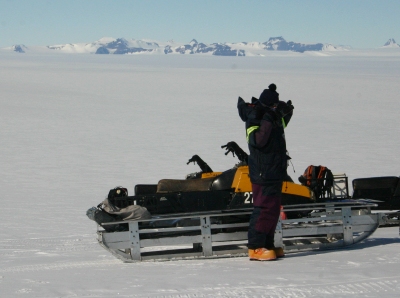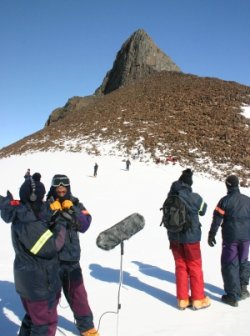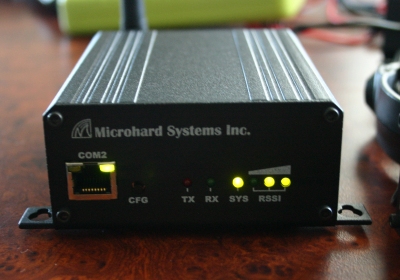I-TASC expedition 2006/2007
Eeek…. just woke up. It’s almost 1300. First Born and I did a radio show for the drivers (they left at 2am), while we made jingles for the station and cables for the ‘studio’. I think we finished about 0600 or so. It was lots of fun.
We struggled with the communication between the AWS (Automatic Weather Station) and radio modems today. So far no success. We know we can install a low-powered computer in the unit containing the AWS but this is not the most efficient or preferred method. So we will methodically try all options in the configuration of the modem tomorrow.
In the meantime, the station is up and broadcasting loud and clear FM. We need some radios (receivers) so we are hoping that Marko can get some on the plane that will bring us gear on Jan 11th. The good news is also that we have been given a desk in the HF Radar room that we can use as a studio. It’s perfect. We have plenty of desk space and a nice view etc. It even has a PC running Linux that we can use for the station’s music library. It took a little bit of work to get the cables through the ducting system but we managed with the assistance of our roommate Remmy.![]()
So now if anyone wants to make some radio, they need just creep into that room and do a show. Already we have First Born doing interviews, and as I write he is DJing with a couple of the over-wintering crew from last winter.
Meanwhile, Tom and I had a good conversation about the AWS. I had understood the AWS unit (a metal box which will house the AWS, computer, batteries, solar panels) was a foundation stone for the lab Tom and Marko had envisioned would be installed in Antarctica. However, it seems actually the unit is for testing the remote communications systems and power systems. Hence there is no real need to host the unit remotely, it might as well be installed in the scientific area at SANAE, making it easier to monitor and maintain but also it can serve as a good prototype for the power and communication systems during a full cycle of seasons in Antarctica.
It also seems Tom is not so keen on making a remote lab for art and is more interested in trying to establish a unit for scientific purposes, something like an ‘away station’. I believe the idea that the lab would be portable has been current in most of the plans so far for this development. I will help think through these ideas but I think it might be more interesting to think through whether cultural residencies in Antarctica are a good idea, and then if the answer is ‘yes,’ then how this could be achieved. I am still very unsure as to the necessity of this but I am enjoying the discussions with Tom and I am keeping my mind open to alternative reckonings.
As for what I am specifically doing and its relevance- again, I am unsure about it. As I said in earlier postings, it is an amazing experience being here in Antarctica and I must say just being here has taken Antarctica out of the realm of mythology for me and placed it firmly in my emotional landscape. I now feel somehow that I have more of an understanding of our planet just by being here. I have visited many countries over the last few years on every continent (except Antarctica of course) and feel I have learnt something about cultures and people through these experiences. I have often come away from these travels with a feeling I have learnt something about our species. However, this is the first time I feel I have gained such a feeling of connection with the planet we all share.
So, why am I here, in this last wilderness, setting up a radio station? Well, I am not really sure. I was invited to be part of the I-TASC crew and then the FM station was added to the list of projects which I would install as a
r a d i o q u a l i a initiative. There are many reasons for doing the project, one of the most interesting is to experiment with hybrid radio, mixing high frequency radio with FM. We will, for example, start experimenting with the link we have established with the radio modems doing audio broadcasts from remote locations and putting these live-to-air on FM. The station is also a community station for the isolated individuals over winter and it is for the summer team to have some fun and help build the feeling of community. I can plainly see on the faces of those involved and those listening the enjoyment and pleasure the station brings.
However, just two days before turning on the transmitter, I sat in my room and while drinking a coffee, I turned on my portable radio. Over the next few minutes I ran up and down the radio dial on FM, LW, MW and 12 channels of Short Wave. And what did I hear? Static. The sound of the earth’s natural spectrum. There was no ‘artificial’ source of radio emissions anywhere on any dial. I have never had that experience anywhere, and it was a very moving experience. I was reminded of a project r a d i o q u a l i a did in Mexico. It was called ‘.sol’ and we travelled to an isolated spot in Mexico to record sounds of the sun using a large array (collection of antenna) and to mix this with recordings in the same frequency range made in Mexico City. In Mexico City you could not hear the ‘sound’ of the sun as you could only pick up the interference made by so many spurious electromagnetic emissions. The result was a cacophony of artificial buzzes and hums. The recordings of the sun we had from Morelia, on the other hand, were clean lovely rolling static noises. The point was, that in the heart of Mexico City is the sun temple, an important cultural center for the ancient cultures of Mexico. However, now the sun is obscured by the noise of modern electrical life.
.sol made me more aware of the electromagnetic spectrum as an environment, one that we should consider has a natural state, a modified state, and a polluted state.
The question confronting me now is whether I should have occupied this space, however small, with my own transmissions?
Comments
A few people have said that they would like to post comments. Unfortunately, we cannot check web pages from here in Antarctica, so if there was a comment option on the site we wouldn’t be able to read and respond. So, perhaps a way round this is if you would like to make a comment then perhaps just send an email to me : adam@xs4all.nl
If you send a comment I will put it on the diary page of the same day (layout the text as you wish). Please feel free to comment, critique or reflect on what we are doing. We will also be happy to answer questions about what we are doing or our experiences. Additionally, we are very happy to research questions for you as there are many knowledgeable people here that know a lot about Antarctica, the base, and the science that takes place here.
We have about 1K of connectivity so the ‘usual’ length of comments would be fine (a paragraph or two) and obviously we can’t handle attachments. I will then upload the comments when I upload the website every day.


